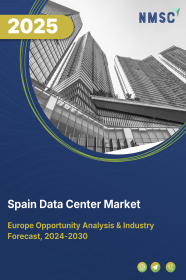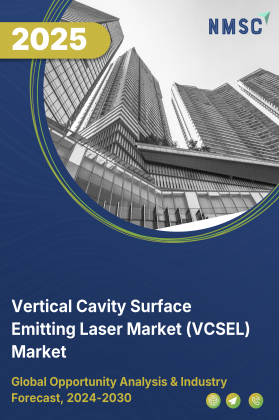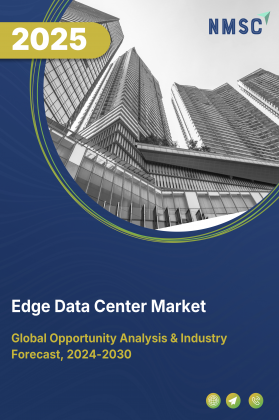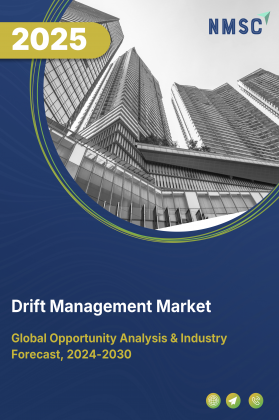
Spain Data Center Market by Infrastructure (Hardware, Software, and Services), by Type (Enterprise Data Centers, and others), by Data Center Rating (Tier I, and others), by Size (Small Data Centers, and others), by Power Capacity (<0.01 GW, 0.01-0.05 GW, 0.05-0.1 GW, 0.1-0.5 GW, and >0.5 GW), by Server Rack Density (<10kW, and others), by Data Center Redundancy (N+1, and others), by PUE Outlook (Less than 1.2, and others), and Others - Opportunity Analysis and Industry Forecast, 2024–2030.
Industry: ICT & Media | Publish Date: 03-Nov-2025 | No of Pages: 210 | No. of Tables: 166 | No. of Figures: 111 | Format: PDF | Report Code : IC2426
Spain Data Center Market Overview
The Spain Data Center Market size was valued at USD 3.79 billion in 2023, and is predicted to reach USD 8.70 billion by 2030, at a CAGR of 12.6% from 2024 to 2030. The data center market, alternatively termed the network infrastructure market, encompasses the complete life cycle of specialized infrastructure dedicated to hosting computing systems, spanning planning, construction, operation, and maintenance phases. It encompasses diverse components such as servers, storage systems, and networking gear, providing a range of services including cloud computing and connectivity solutions.
Presently, the industry is witnessing widespread adoption of cloud services, coupled with the emergence of edge computing aimed at reducing latency. Key trends within the sector include a notable focus on sustainability, heightened concerns surrounding cybersecurity, the integration of hybrid and multi-cloud approaches, and the significant impact of 5G networks.
These trends underscore the industry's proactive response to the escalating demand for scalable, efficient, and secure data processing and storage solutions in the midst of the digital transformation era. According to projections from the United States International Trade Commission, the data processing and storage market is anticipated to expand from USD 56 billion in 2020 to USD 90 billion by 2025.
Escalation of GPU‑accelerated Infrastructures for Next‑Gen AI and Analytics
The surge in generative AI, real‑time analytics and simulation workloads is driving Spanish data centers to adopt high‑density, GPU‑optimized architectures. Leading operators are rolling out modular GPU pods and liquid‑cooling systems designed specifically for machine‑learning training and inference, enabling up to tenfold increases in compute efficiency compared to traditional layouts. This trend is reinforced by enterprise demand for on‑premises AI environments that integrate seamlessly with public‑cloud models, supporting hybrid deployments and burst‑to‑cloud scenarios. In parallel, specialist service offerings—such as AI‑as‑a‑service platforms and managed GPU clusters—are emerging to help organizations accelerate proof‑of‑concepts and scale production pipelines without heavy upfront capital. The result is a rapidly evolving ecosystem in which performance, energy efficiency and operational flexibility converge to meet the needs of AI‑driven digital transformation.
Expansion of Sovereign Cloud Frameworks and Tightened Data Protection Mandates
In response to evolving European and national regulations, Spain has reinforced its focus on sovereign cloud services and strict data‑localization requirements. The government’s “Digital Spain 2026” initiative mandates the deployment of certified, home‑grown cloud platforms for public‑sector workloads, while industry consortia are developing secure enclaves for sensitive financial and healthcare data. Colocation providers are partnering with accredited Spanish cloud operators to bundle connectivity, compute and compliance controls under single‑vendor umbrella agreements, simplifying procurement and audit processes. At the same time, privacy regulators are tightening enforcement of GDPR principles, prompting enterprises to adopt rigorous data‑governance frameworks and containerized, region‑locked deployments. This regulatory backdrop is catalyzing investments in private‑cloud build‑outs, dedicated vaults and turnkey sovereign‑cloud offerings, reinforcing Spain’s position as a trusted hub for regulated and mission‑critical digital services.
Grid Capacity Limitations and Renewable Integration Challenges
Although Spain boasts one of Europe’s fastest‑growing renewable‑energy portfolios, its transmission network and interconnection capacity lag behind data‑center demand, creating critical bottlenecks. Operators face prolonged permitting timelines for new power lines and substations, while rapid solar and wind build‑outs strain distribution feeders—driving up spot prices during peak compute hours. At the same time, large‑scale battery storage remains cost‑prohibitive, forcing facilities to rely on diesel generators for resilience and undermining sustainability targets. These grid constraints not only elevate capital and operating expenditures, but also deter midsize and edge‑focused providers from expanding, consolidating advantage among hyperscale incumbents with deeper pockets and prioritized grid access.
Emerging Edge‑to‑cloud Convergence Enabled by 5G Standalone
The rollout of 5G Standalone networks is catalyzing the emergence of integrated edge‑to‑cloud ecosystems, driving demand for micro‑data centers at cell sites, campuses, and enterprise premises. By embedding compute, storage, and network functions within 5G cores, providers can support ultra‑low‑latency use cases—such as real‑time AR/VR, autonomous systems, and time‑sensitive industrial control—while maintaining seamless connectivity to centralized clouds. Partnerships between hyperscalers, telecom operators, and neutral‑host edge specialists are delivering turnkey multi‑access edge compute (MEC) platforms, extending Spain’s digital infrastructure into new urban and rural markets. This trend not only broadens service reach and resilience but also fosters localized innovation in IoT, smart mobility, and immersive media.
Competitive Landscape
The key market players operating in the Spain data center industry include AtlasEdge, Amazon Web Services, Microsoft, NTT, EdgeConneX, Digital Realty Trust Inc., CyrusOne Inc., Colt Data Centre Services, Iron Mountain Incorporated, Global Switch Holdings Limited, Equinix Inc., Nabiax, Telefónica, S.A., Adam Data Center, Civicos Networking, and others.
Spain Data Center Market Key Segments
By Infrastructure
-
Hardware
-
IT Hardware
-
Servers
-
Storage Systems
-
Networking Equipment
-
-
Power Infrastructure Hardware
-
Uninterruptible Power Supplies (UPS)
-
Generators
-
Automatic Transfer Switches
-
Power Distribution Units (PDUs)
-
-
Mechanical Infrastructure Hardware
-
Computer-Room Air Conditioners (CRAC/CRA Units)
-
Chillers
-
Racks
-
Cable Management Systems
-
-
Safety & Security Hardware
-
Fire Suppression Systems
-
Physical Security Systems (CCTV, access controls)
-
-
-
Software
-
DCIM & Monitoring
-
Automation & Orchestration
-
Backup & Disaster Recovery
-
Security Software
-
Virtualization Software
-
Analytics & Reporting Software
-
Other Software
-
-
Services
-
Planning & Professional Services
-
Site & Building Design
-
System/Infrastructure Engineering
-
Professional Advisory (compliance, energy audits)
-
-
Integration & Deployment Services
-
Electrical & Mechanical Installation
-
Commissioning & Acceptance Testing
-
-
Operation & Support Services
-
Preventive & Corrective Maintenance
-
Facilities Management / Remote Monitoring
-
Support Services (helpdesk, onsite SLA support)
-
-
Hosting & Managed Services
-
Colocation & Cloud Hosting Services
-
Virtual/Private Hosting Platforms
-
-
By Type
-
Enterprise Data Centers
-
Colocation Data Centers
-
Cloud Data Centers
-
Hyperscale Data Centers
-
Edge Data Centers
-
Micro Data Centers
-
Others
By Data Center Rating
-
Tier I
-
Tier II
-
Tier III
-
Tier IV
By Size
-
Small Data Centers
-
Med-sized Data Centers
-
Large Data Centers
By Power Capacity
-
<0.01 GW (Small)
-
0.01-0.05 GW (Medium)
-
0.05-0.1 GW (Large)
-
0.1-0.5 GW (Hyperscale)
-
>0.5 GW (Mega-campus)
By Server Rack Density
-
<10kW
-
10-19kW
-
20-29kW
-
30-39kW
-
40-49kW
-
>50kW
By Data Center Redundancy
-
N (No Redundancy)
-
N+1 (Single-fault tolerant)
-
N+2 (Dual-fault tolerant)
-
2N (Full duplication)
-
2N+1 (Concurrently maintainable + extra spare)
-
3N/2N+2 (Multi-backup fault tolerant)
By PUE Outlook
-
Less than 1.2
-
1.2 - 1.5
-
1.5 - 2.0
-
Greater than 2.0
By Design Outlook
-
Traditional
-
Containerized
-
Modular
By End User
-
Cloud Service Provider
-
Technology Provider
-
Telecom
-
Healthcare
-
BFSI
-
Retail & E-commerce
-
Entertainment & Media
-
Government
-
Energy
-
Others
Key Players
-
AtlasEdge
-
Amazon Web Services
-
Microsoft
-
NTT
-
EdgeConneX
-
Digital Realty Trust Inc.
-
CyrusOne Inc.
-
Colt Data Centre Services
-
Iron Mountain Incorporated
-
Global Switch Holdings Limited
-
Equinix Inc.
-
Nabiax
-
Telefónica, S.A.
-
Adam Data Center
-
Civicos Networking
Report Scope and Segmentation
|
Parameters |
Details |
|
Market Size in 2023 |
USD 3.79 Billion |
|
Revenue Forecast in 2030 |
USD 8.70 Billion |
|
Growth Rate |
CAGR of 12.6% from 2024 to 2030 |
|
Analysis Period |
2023–2030 |
|
Base Year Considered |
2023 |
|
Forecast Period |
2024–2030 |
|
Market Size Estimation |
Billion (USD) |
|
Growth Factors |
|
|
Companies Profiled |
15 |
|
Market Share |
Available for 10 companies |
|
Customization Scope |
Free customization (equivalent up to 80 working hours of analysts) after purchase. Addition or alteration to country, regional, and segment scope. |
|
Pricing and Purchase Options |
Avail customized purchase options to meet your exact research needs. |

















 Speak to Our Analyst
Speak to Our Analyst

























